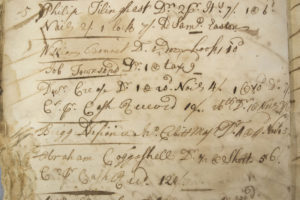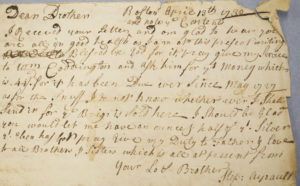It isn’t always obvious who authored an historic document; often, the writer didn’t think to record their name. Without a clear signature naming the writer, researchers must find other methods for determining the creator. Often these methods produce an educated guess, derived from the content of the document, contextual clues, or handwriting comparisons. Sometimes historians disagree about who created a document, or new information may lead a researcher to a different conclusion than that of the historians who came before her.
This is precisely the case for an 18th century daybook in the Newport Historical Society’s collection. This daybook chronicles daily transactions between 1733 and 1734 of a merchant selling goods, including household items and hardware. Based on the names of customers, which include renowned craftsmen like William Claggett and Christopher and Job Townsend, we are confident this merchant was based in Newport. However, the volume is not inscribed anywhere with conclusive information identifying its creator.
In Master Craftsmen of Newport: The Townsends and Goddards (1984), Michael Moses ascribed this daybook to Solomon Townsend. Moses did not explain the rationale behind this attribution, although he did note, “There is some dispute whether this is his book.” Since the publication of Master Craftsmen of Newport, some scholars have cited the daybook from Moses, without looking at the original manuscript. As a result, this daybook has been frequently credited to Solomon Townsend.
Over the past several months, Pat Kane, the Friends of American Arts Curator American Decorative Arts at Yale University, has carefully read through this daybook and other account books in NHS’ collection. Based on her analysis and comparison to other records, it appears that the Solomon Townsend attribution is mistaken. We believe this volume is the work of Stephen Ayrault (1709-1794), a merchant of Newport. From correspondence in NHS’ manuscript collection, we know that Ayrault frequently bought, sold and shipped hardware. Furthermore, comparing handwriting from the unattributed daybook to other documents written and signed by Stephen Ayrault suggests that these were all likely penned by the same hand (compare the detail images of two documents, below).
This case points to the value of looking at the original primary sources cited by scholars. Historians must interpret their sources based on the information available to them, which is not always complete. Sometimes revisiting a document years later, after new information has come to light, can lead to a different and more accurate interpretation of the same source.

Detail of a page from the 1733-1734 daybook, which we now believe belonged to Stephen Ayrault. NHS Collection, vol. 703.

Detail of April 13th 1730 letter written and signed by Stephen Ayrault, to his brother Daniel. NHS collection, Box 36A Folder 8.